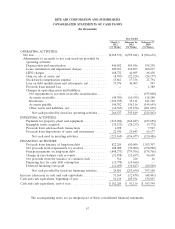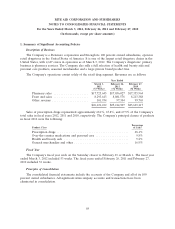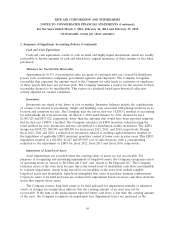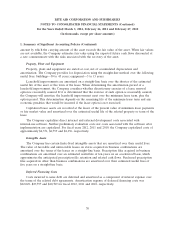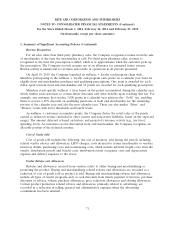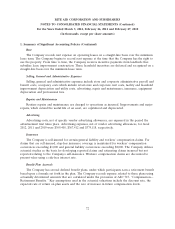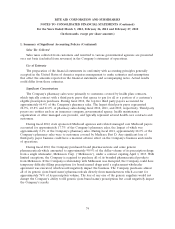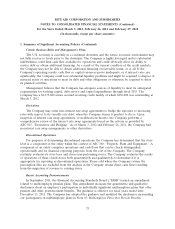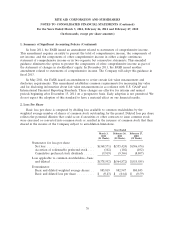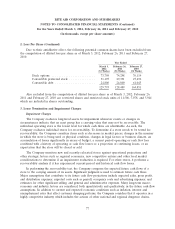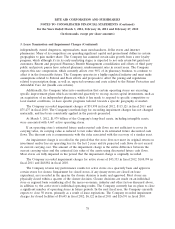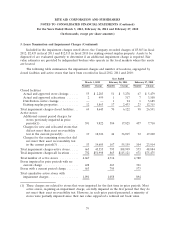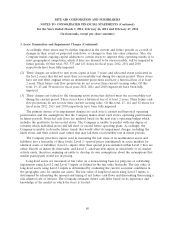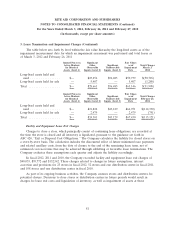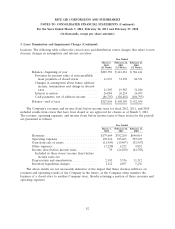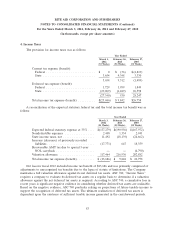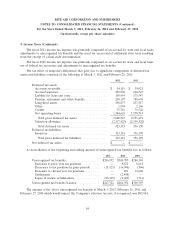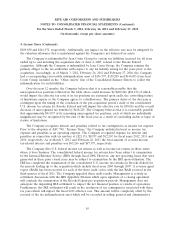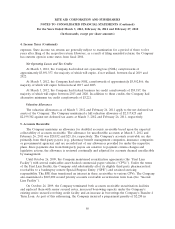Rite Aid 2012 Annual Report Download - page 77
Download and view the complete annual report
Please find page 77 of the 2012 Rite Aid annual report below. You can navigate through the pages in the report by either clicking on the pages listed below, or by using the keyword search tool below to find specific information within the annual report.
RITE AID CORPORATION AND SUBSIDIARIES
NOTES TO CONSOLIDATED FINANCIAL STATEMENTS (Continued)
For the Years Ended March 3, 2012, February 26, 2011 and February 27, 2010
(In thousands, except per share amounts)
2. Loss Per Share (Continued)
Due to their antidilutive effect, the following potential common shares have been excluded from
the computation of diluted loss per share as of March 3, 2012, February 26, 2011 and February 27,
2010:
Year Ended
March 3, February 26, February 27,
2012 2011 2010
(53 Weeks) (52 Weeks) (52 Weeks)
Stock options ......................... 73,798 74,298 76,114
Convertible preferred stock ............... 31,195 29,391 27,692
Convertible debt ....................... 24,800 24,800 61,045
129,793 128,489 164,851
Also excluded from the computation of diluted loss per share as of March 3, 2012, February 26,
2011 and February 27, 2010 are restricted shares and restricted stock units of 11,506, 7,078, and 5,944
which are included in shares outstanding.
3. Lease Termination and Impairment Charges
Impairment Charges
The Company evaluates long-lived assets for impairment whenever events or changes in
circumstances indicate that an asset group has a carrying value that may not be recoverable. The
individual operating store is the lowest level for which cash flows are identifiable. As such, the
Company evaluates individual stores for recoverability. To determine if a store needs to be tested for
recoverability, the Company considers items such as decreases in market prices, changes in the manner
in which the store is being used or physical condition, changes in legal factors or business climate, an
accumulation of losses significantly in excess of budget, a current period operating or cash flow loss
combined with a history of operating or cash flow losses or a projection of continuing losses, or an
expectation that the store will be closed or sold.
The Company monitors new and recently relocated stores against operational projections and
other strategic factors such as regional economics, new competitive entries and other local market
considerations to determine if an impairment evaluation is required. For other stores, it performs a
recoverability analysis if it has experienced current-period and historical cash flow losses.
In performing the recoverability test, the Company compares the expected future cash flows of a
store to the carrying amount of its assets. Significant judgment is used to estimate future cash flows.
Major assumptions that contribute to its future cash flow projections include expected sales, gross profit,
and distribution expenses; expected costs such as payroll, occupancy costs and advertising expenses; and
estimates for other significant selling, and general and administrative expenses. Many long-term macro-
economic and industry factors are considered, both quantitatively and qualitatively, in the future cash flow
assumptions. In addition to current and expected economic conditions such as inflation, interest and
unemployment rates that affect customer shopping patterns, the Company considers that it operates in a
highly competitive industry which includes the actions of other national and regional drugstore chains,
77


